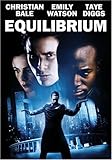The Gothic War: Rome’s Final Conflict in the West
Contesting the Gothic: Fiction, Genre and Cultural Conflict, 1764-1832 (Cambridge Studies in Romanticism)
The Gothic War: Rome’s Final Conflict in the West
Equilibrium

Amazon.co.uk Review
From the outset, Star Trek: Deep Space Nine was about conflict. Producers Rick Berman and Michael Piller challenged the utopian ideals of Gene Roddenberry’s Star Trek universe to create something totally different from its predecessors. That meant no familial camaraderie, squeaky-clean Federation diplomacy, or beige décor. Instead they wanted interpersonal friction, ruthless enemies (Gamma Quadrant Imperialists–The Dominion) and rebellion at every turn. The DS9 concept was originally facilitated by introducing the Cardassian/Bajoran war during The Next Generation‘s final days. After a muted first reception fans gradually came to accept the new look, but no one liked Star Trek without a starship and eventually the producers capitulated to viewers’ wishes by introducing the USS Defiant (an apt name) in Season 3.
Relying far less on technobabble than TNG, DS9 was unafraid to focus on matters of the spirit instead, demonstrating a ballsy independence from its parent shows. Taking up the gauntlet thrown down by Babylon 5, improved CGI space battles also became a fan favourite. Throughout the increasingly serialised story arc there were rebellious factions within the different establishments: Kira had belonged to the Shakaar resistance cell; the Maquis was Starfleet vs Cardassians; section 31 was a secret Starfleet group; the True Way was a Bajoran group opposed to peace; the Cardassians had their Obsidian Order and the Romulans their Gestapo-like Tal Shiar. Yet for all its constant bickering and espionage (even Bashir got to be James Bond), there was always some contemporary social commentary lurking: the Ferengi were used as a comedic foil to frown on materialistic greed; drugs were looked at via the Jem’Hadar foot soldiers’ addiction to Ketracel White.
Perhaps Sisko summed up the real heart of things: “Bajor doesn’t need a man, it needs a legend”. A future vision that retains a place for religion and spirituality turned out to be Deep Space Nine‘s first best destiny. –Paul Tonks

